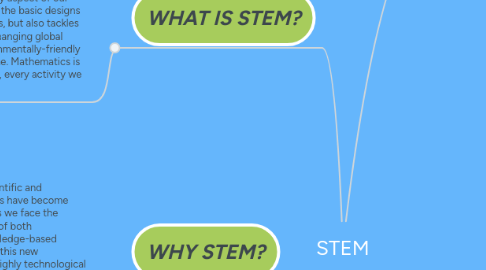STEM
создатель John Michael Morata

1. WHAT IS STEM?
1.1. STEM stands for science, technology, engineering, and mathematics.Science is everywhere in the world around us.Technology is continuously expanding into every aspect of our lives. Engineering is the basic designs of roads and bridges, but also tackles the challenges of changing global weather and environmentally-friendly changes to our home. Mathematics is in every occupation, every activity we do in our lives.
2. WHY STEM IS IMPORTANT?
2.1. STEM is important because it pervades every part of our lives
3. WHY STEM?
3.1. “In the 21st century, scientific and technological innovations have become increasingly important as we face the benefits and challenges of both globalization and a knowledge-based economy. To succeed in this new information-based and highly technological society, students need to develop their capabilities in STEM to levels much beyond what was considered acceptable in the past.”
4. Who benefits from STEM?
4.1. STEM education helps to bridge the ethnic and gender gaps sometimes found in math and science fields. Initiatives have been established to increase the roles of women and minorities in STEM-related fields. STEM education breaks the traditional gender roles. In order to compete in a global economy, STEM education and careers must be a national priority. Each and every decision made uses an aspect of STEM to understand the implications.
5. SUBJECTS
5.1. EMPOWERMENT TECHNOLOGY
5.1.1. Empowerment Technology is a professional web and software development company and providing technical training on various technologies.
5.2. GENERAL MATHEMATICS
5.2.1. The General Mathematics program aims to provide students with the knowledge of mathematics in its breadth by drawing its courses from the department's different mathematical divisions: Applied Mathematics, Pure Mathematics, Statistics and Actuarial Science.
5.3. PRE. CALCULUS
5.3.1. Pre calculus is a course that includes algebra and trigonometry at a level which is designed to prepare students for the study of calculus. Schools often distinguish between algebra and trigonometry as two separate parts of the coursework.
5.4. EARTH SCIENCE
5.4.1. Earth science includes all fields of natural science related to the planet Earth.Earth science is the study of our planet’s physical characteristics, from earthquakes to raindrops, and floods to fossils.
5.5. SOCIAL SCIENCE
5.5.1. Social science is a category of academic disciplines, concerned with society and the relationships among individuals within a society. Social science as a whole has many branches, each of which is considered a social science. The social sciences include, but are not limited to: anthropology, archaeology, communication studies, economics, history, human geography, jurisprudence, linguistics, political science, psychology, public health, and sociology.
6. Here are 8 benefits of STEM education:
6.1. Prepares children for upcoming technological innovations: It teaches kids to be proactive about technology. It prepares kids for the technological innovations they will undoubtedly experience in their lifetime. More and more, technology is an integral part of life that kids need to understand.
6.2. Enhances problem-solving skills: STEM education builds and encourages problem-solving skills. In STEM activities, students learn how to analyze problems and then work to correct and overcome them.
6.3. Greater understanding of concepts: Children need to engage and apply concepts in a deeper, more thorough way, leading to a greater understanding of the concepts.
6.4. Application of knowledge: STEM is motivating, engaging and real-world inspired. Knowledge is taught the way it is used in the real world, with concepts and subjects interwoven seamlessly. Children integrate and apply all this knowledge.
6.5. Instills creativity and innovation: Creativity can co-exist with science and technology and lead to creative careers like in Architecture and Graphic Design.In our world of innovation, creativity is the fuel for new technologies and ideas. Creativity allows students to see problems in new ways and to think outside of the box.
6.6. Teaches Teamwork, collaboration, and communication: STEM makes it accessible to children of all levels of ability. Even within one team, various ability levels can work together and learn together. Communicating your finding and solutions accurately and effectively whether through recording data, writing reports, or giving presentations is key to taking action.
6.7. Encourages Risk Taking: Observing needs, developing ideas, experimenting with solutions encourages an important level of risk-taking that many kids want to avoid. Children will learn to stand up for their idea, make it happen, and if it fails, to try again.
6.8. Complete Process Learning: Children will experience the whole process of completing a project from start to finish. The skills to learn how to research, plan, gather data, design, and draw conclusions are vital to the success of kids looking to solve real-life needs.
6.9. Builds Perseverance and Determination: Students have the freedom of thinking critically, creatively and to innovate. And opportunities are provided for children to fail and try again in a safe environment. It emphasizes the value of failure as a learning opportunity and helps embrace the mistakes. It gives kids confidence to make goals and take measurable steps to achieve them.
6.10. Fosters a love of learning: STEM fosters a love of learning, instilling a passion and drive to learn. It drives curiosity and a belief in the abilities of the child and a thirst for knowledge. With these skills in their toolbox, they will be equipped to tackle the challenges of higher education and the real world.


